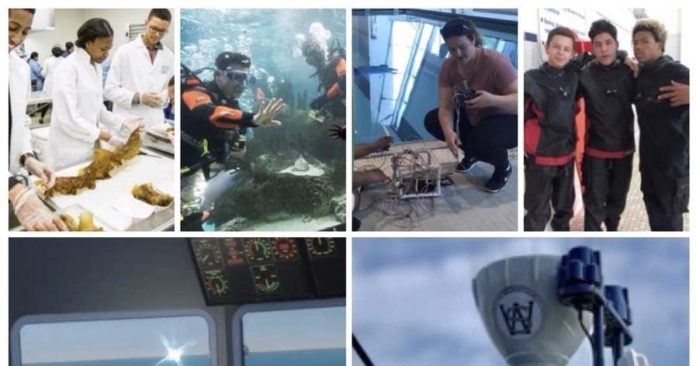03/04/2021 02:02 p.m. EST
As we look to the future, thoughts of how Long Island Sound will plot its way are surfacing. Nature’s influences on habitat and the surrounding environment is a major factor, even though humans have had a far greater impact than many realize. Nevertheless, this unique body of water has always been embraced by sea goers, whether related to their livelihoods or their recreation.
Through the years, we have seen a growth in the Sound’s usage both socially and economically. There has been more and more interest in using this body of water for development in one form or another. As we look toward our oceans as a source of renewable sustenance and a possible aid to energy generation, we also delve into what type of training and education would be necessary in preparing future generations for life on, in, or near the water.
As a member of The Sound School’s Advisory and Consulting Committee, I was inspired to see such detailed plans laid out for the near future. Input was sought from the group as to how relevant programs and services can be enhanced to provide current and future jobs’ needs in the region, while fulfilling realistic needs and interests of the students. Gathered around a virtual table hosted by Tim Visel, aquaculture science coordinator, and Peter Solomon of environmental and underwater sciences, ideas and suggestions were exchanged by attendees representing a complement of agencies, institutions, organizations, and companies including the National Oceanic and Atmospheric Administration’s Marine Fisheries Service, Yale University, the Connecticut Department of Agriculture, UConn Avery Point, and GreenWave
The new and greatly expanded multi-level waterfront Sound School facility will house various labs and classrooms focusing on fish production, seafood production, habitat simulation, scientific diving, GIS and computer navigation, ocean engineering, and an outdoor weather station. These alone are projected to total 11,600 square feet and provide resources for prime technically advanced learning—a substantial improvement over current operations. The new building will be tactically updated to where career-oriented students can continue to learn all facets of marine life, take the knowledge obtained, and apply it to the ever-changing waters of the world.
As interest in Long Island Sound continues to grow, it is important that there is an asset like The Sound School, a state Board of Education regional education and aquaculture center, that offers such a broad marine curriculum, as well as regular and advanced high school courses. It is a distinctive learning facility located in New Haven’s historic Long Wharf area, serving as a four-year comprehensive public high school that incorporates a marine-themed college preparatory program. If the sweet or briny runs in the family, check out this progressive and well-seasoned school for upcoming mariners at www.soundschool.com.
On the Water
For now, most of the wintry weather has passed, leaving only a glimpse in the rearview mirror. March has always had a few surprises, but mostly just amounts to the last gasps of the cold season. Meanwhile, Long Island Sound inshore water temperatures have been around the 35-degree mark and will be slowly climbing as longer days and stretches of warmer weather gradually take hold. Look for cooler winds of the north to shift to the south and southwest for a time.
Recent snowfall that had piled up on the ground provided a good soaking and a dose of refreshment for our rivers and streams. Several of the Trout Management Areas have already had their first stocking of the season, creating excellent opportunities for anglers to fine-tune their catch and release skills. Most of the fish have been caught while spinning with small inline spinners, swimmers, and bait (live shiners, worms, grubs) or while fly fishing drifting nymphs or stripping streamers.
On breakaway days when better conditions prevailed, Atlantic salmon catches were up in the two key rivers, the Shetucket and the Naugatuck. Flows and depths moderated, making fishing for these fish less of an effort. However, when hooked, these fish have a built-in defense mechanism that takes over, causing the fish to dive to the bottom. Therefore, it is imperative to maintain a high rod position to prevent the line from sinking below the water’s surface and snagging bottom. Anyone who has ever experienced that can tell you that the fight will invariably end posthaste as your silvery would-be catch disappears upriver.
Brighter days, along with warmer air temperatures, have caused a meltdown and, at the very least, slushy and variable conditions for ice fishing. That has been more evident along the shoreline south of I-95. Farther north, though, ice conditions have been better as the typical species of largemouth bass, pickerel, yellow perch, black crappie, trout, and northern pike have been iced. Still, an effort must be made to check ice conditions for safety’s sake when venturing out to stagger tip-ups and drill jigging holes.
Small schools of cold water oriented baitfish like herring have been the source of food for harbor seals, eagles and, yes, striped bass that have held over in some rivers and periodically headed into the Sound for a bite. All indications point to an early run and, when that happens, make sure you employ the use of inline circle hooks when natural bait fishing unless there are any last-minute exemptions adopted. We are expecting another banner year for black sea bass and porgy (scup), so shore up those dinner table recipes. For now, add some clams courtesy of the recent full eagle moon tides.
Note: Email us pics of your catches to share with our USA and international fishing friends who keep up with the latest fishing news and frequent social media.
For all things fishy including rods, swing by the shop (203-245-8665) open seven days located at 21 Boston Post Road, Madison. Until next time from your Connecticut shoreline’s full-service fishing outfitter, where we don’t make the fisherman, we make the fisherman better.
Tight Lines,
Captain Morgan
captainmorganusa@hotmail.com
captainmorgan-fish.blogspot.com
twitter @captmorgan_usa
Credit: Source link































